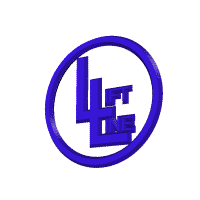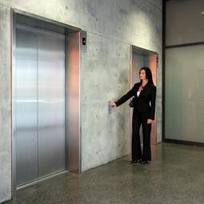

CONTENTS - MENU
Liftline Limited - Machine room less Lift - MRL - Design Consultants
Machine room less lifts, or MRL's, are rapidly becoming the design of choice in todays market. Machine room less lifts have all equipment located within the lift shaft, or on the landings, and do not need a separate room to house the winding machine and control panel etc. Particularly in new build applications, Architects naturally like to adopt the fact that no rooftop lift motor housing is required allowing a clean roofline and maximising letable space.
The manufacturers of such lifts rightly expound the environmental virtues of some of the lifts currently available. Some are particularly energy efficient and have a low polution impact, compared, for example, with hydraulic lifts. The Kone Monospace has an inivative drive machine called the Ecodisk which comprises a gearless unit driven by a directly coupled AC variable frequency motor. The Otis Gen II uses preformed rubber belts, rather than standard wire ropes, which allow greatly reduced sheave diameters thus saving space on the lift arrangement. However these types of elevators are relatively new and many aspects are not well known or indeed understood.
As Lift Consultants, Liftline Limited, are well versed in machine room less elevators and it is our responsibility to advise our Clients as to the drawbacks, as well as the benefits of these types lifts depending upon circumstances.
From a construction point of view, there can be differences in the installation method that effect the Contractor. On a recent installation, the Lift Contractors scaffolding was extended out onto the lobby landing at the top floor which prevented finishing works in the lobby area. Naturally this need only be a programming ammendment, however, the vital information relating to the installation method was not made clear and thus caused unnecessary delays.
From a purchasers point of view, many machine room less elevators are based around an existing package lift design. This means that many such lifts are somewhat limited with regard to robustness; door panels and cars are often flimsy making them susceptable to even minor vandalism or abuse. The result of this alignment to low cost packages means that the elevator can be very financially attractive but in some instances the application may not be so suitable. Liftline recently inspected a tender companies last similar machine room less installation to assess its suitability. The offered lift was very financially attractive and it was obvious why. After six months the lift was in very poor condition; finishes were damaged and between breakdowns, the lift performance was most unsatisfactory.
As far as the user is concerned, there is very little difference under normal conditions between a machine room less lift and any other traction drive unit. However because the winding machine is located inside the shaft it is not directly accessible. During a power failure, the traction drive lift can be manually moved up or down so that passengers can be released from the nearest floor. Under normal circumstances the car would be moved in the direction of least resistance determined by whether the car or counterweight is heavier. Should circumstances dictate that the car is moved in a particular direction, for example a fire on the floor below a fully loaded car, this can be achieved, if purhaps, it takes a little effort. Where the drive machine is not directly accessible, the full control in an emergency is not possible. On some machineroomless applications a battery back up system can be provided, as an extra cost, but it often cannot move a fully loaded car and this, we believe, does not comply with the spirit of the European Standard.
It should be remembered, that all machine room less lifts were bourne out of an attempt to circumvent the need for a motor room by manipulating the existing British and European Standards so that they can be deemed to comply. Unfortunately some factors of these lifts are considered rather makeshift. For example many lifts rely on a bourden cable to release the machine brake, whereas the release on traction lifts can be directly operated by hand. This little modification could allow a simple failure of a part that did not previously exist to become a major problem.
The best known MRL's are manufactured by the largest Lift Manufacturers, however these days many smaller companies can supply MRL models. These are frequently manufactured by Spanish or Italian companies and purchased as a complete package. This means that the company awarded a contract may only be directly responsible for the installation and not the design. The quality of European lifts can vary tremendously, some being particularly poor. The control systems and the lift as a whole can be difficult to maintain and spares can be hard to obtain.
As with any lift it is essential that the servicing company not only has extensive knowledge of the product but has ready access to spare parts. Some of the larger companies use this fact to tie clients into contracts which can provide long term additional revenue to compensate for low installation costs. This aspect in no way only apples to machine room less lifts but it is considered worth mentioning at this time.
As previously stated, the machineroomless lift depends on the relocation of motor room parts in order to negate the need for a separate room. This means that a new position for the control panels needs to be found. In most cases the panels are incorporated into extended architraves or special panels, usually at the top floor. Not only must the visual aspects of the panels be accepted by the Client, their position increases the maintenance necessary at this landing. In an office block this could cause some disturbance, but if children or animals are resident, it could cause an increased risk to the safety of all, including the maintenance engineer.
The above comments are intended to advise clients that in some cases the MRL lift option may not be the panacea to all elevator problems as may be inferred by the manufacturers. Clients must take care to fully explore the particular design criteria that applies to the various models on offer and ensure they fully understand the implications in adopting, what is, a relatively new arrangement.
Liftline have been operating since 1987 providing a range of services across Britain. Liftline, lift consultants, can assist on new build projects, repairs, refurbishment's and modernisation's.
Visit our website for more information on the Company. You will also find information pages on related subjects such as EN81, LG1 periodic testing and the Lifts Regulations.

(c) Copyright 2010 - http://www.liftline.co.uk
